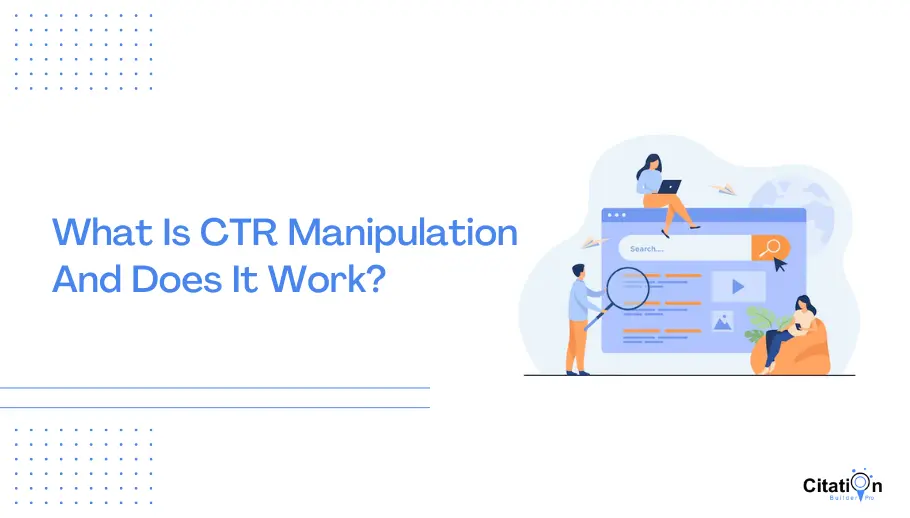Boost Your Service Exposure with Our CTR Manipulation Service
Boost Your Service Exposure with Our CTR Manipulation Service
Blog Article
Optimizing Organic Click-Through Fees With CTR Control
The optimization of organic click-through prices (CTR) is a nuanced venture that hinges on comprehending both user psychology and effective web content discussion. The landscape is swarming with false impressions and oversimplifications concerning what really drives CTR.
Understanding Click-Through Fees
Understanding click-through rates (CTR) is important for assessing the effectiveness of internet marketing strategies. CTR measures the percent of individuals that click a particular link or advertisement compared to the total variety of customers that watch it. A greater CTR shows that the web content is involving and appropriate to the target market, while a reduced CTR may signal a requirement for optimization.
To compute CTR, separate the number of clicks by the variety of perceptions and increase by 100. If an advertisement receives 300 clicks out of 10,000 impressions, the CTR would be 3%. This statistics is crucial for evaluating different elements of electronic advertising and marketing, including search engine optimization (SEARCH ENGINE OPTIMIZATION), e-mail projects, and social networks advertising.
Furthermore, analyzing CTR aids marketers identify which methods produce the most effective outcomes and which call for refinement. By concentrating on improving CTR, companies can enhance their material's visibility and effectiveness, causing boosted website traffic and prospective conversions. Recognizing the nuances of CTR is fundamental for any type of marketing expert aiming to optimize their on the internet existence and optimize return on investment (ROI)

The Psychology of Individual Actions
Individual habits is dramatically affected by mental elements that determine just how people connect with on-line material. Recognizing these factors is essential for maximizing click-through prices (CTR) in organic search outcomes. Cognitive predispositions, such as the anchoring result, play a critical role in forming individuals' understandings. Their initial impressions can greatly affect their subsequent judgments concerning relevance and reliability. when individuals run into details.
Psychological reactions likewise significantly effect user behavior. Web content that resonates emotionally can set off a feeling of necessity or interest, prompting customers to click. In addition, social evidence-- such as individual testimonials or scores-- can enhance count on and urge interaction, as individuals usually want to the actions of others to educate their own choices.
Furthermore, the concept of deficiency can drive clicks - CTR Manipulation Service. Limited-time offers or exclusive content create a fear of missing out (FOMO), engaging users to act promptly. Understanding these psychological drivers enables online marketers to develop even more compelling web content that reverberates with their target audience
Reliable CTR Control Methods
Leveraging mental understandings can substantially improve click-through prices (CTR) with targeted control methods. One of the most effective approaches is making use of compelling headings that stimulate inquisitiveness or seriousness. Phrasing titles as inquiries or incorporating numbers can draw in more interest, prompting users to click.
Another method entails optimizing meta descriptions to create a sense of importance and immediacy. By plainly laying out the benefits or remedies given in the content, you can engage prospective viewers and encourage them to click. Additionally, making use of power words-- such as "unique," "shown," or "cost-free"-- can enhance the charm of your web content.
Visual aspects likewise play a vital function. Incorporating appealing images or thumbnails can draw customers in and enhance CTR. A/B testing various visuals can aid identify which pictures reverberate best with your target market.
Lastly, guaranteeing that your web content guarantees deliverable worth leads to greater CTR. They are more most likely to involve when individuals view that clicking will offer them with significant insights or solutions. By using these methods thoughtfully, marketing professionals can efficiently control CTR to their benefit while preserving ethical requirements.
Usual Myths Regarding CTR
Numerous misconceptions border click-through rates (CTR) that can lead online marketers to make misguided decisions. While a high CTR suggests that even more customers are clicking, it does not ensure sales or conversions.
Another usual idea is that CTR is an isolated metric. Actually, CTR ought to be evaluated combined with other performance signs, such as bounce rate and conversion price, to gain an all natural sight of campaign success.
Furthermore, some marketers assume that maximizing for CTR alone suffices. Nevertheless, concentrating exclusively on CTR can bring about clickbait strategies that might draw in clicks but fall short to involve individuals meaningfully. This strategy can damage brand name track record and result in lower retention prices
Lastly, there is an idea that CTR strategies are widely effective. The reality is that optimum CTR techniques can vary substantially throughout industries and target market, requiring tailored strategies for different market segments. Recognizing these myths is crucial for establishing efficient CTR techniques that line up with overarching marketing objectives.
Determining CTR Success
Although high click-through rates (CTR) can show successful involvement with web content, measuring their real success needs a comprehensive analysis of numerous factors. First, it is vital to recognize the context in which the CTR is attained. A high CTR on a deceptive title may not equate to meaningful engagement or conversions, ultimately mirroring inadequately on the brand's credibility.
2nd, evaluating the source of traffic is crucial. Organic website traffic from internet search engine CTR Manipulation Press Release can represent a durable material technique, while clicks from pointless sources might suggest a lack of targeting. In addition, determining the subsequent user actions is important; examining metrics such as bounce rate, time invested in web page, and conversion prices can give much deeper understandings into the top quality of the interaction started by the CTR.

Final Thought

The optimization of organic click-through prices (CTR) is a nuanced venture that pivots on understanding both individual psychology and effective material presentation. CTR measures the portion of users that click on a certain link or promotion compared to the total number of users that view it. A higher CTR suggests that the material is involving and relevant to the target audience, while a reduced CTR may signal a requirement for optimization.
Focusing solely on CTR can lead to clickbait tactics that may attract clicks yet stop working to involve customers meaningfully. Additionally, measuring the succeeding individual behavior is essential; assessing metrics such as bounce price, time spent on page, and conversion rates can provide much deeper understandings into the quality of the interaction launched by the CTR.
Report this page